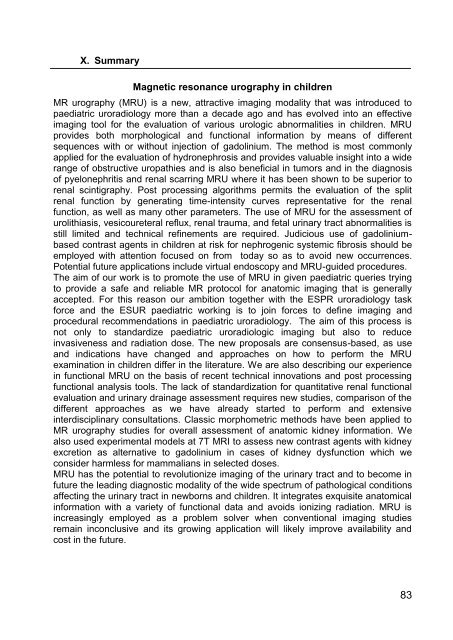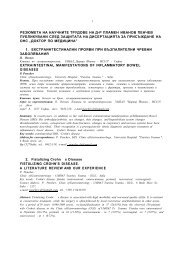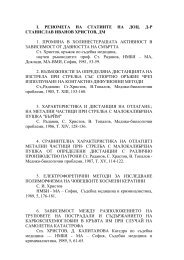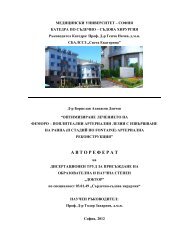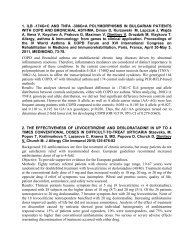ÐеклаÑаÑÐ¸Ñ Ð·Ð° оÑигиналноÑÑ - ÐÐÐÐЦÐÐСÐРУÐÐÐÐРСÐТÐТ ...
ÐеклаÑаÑÐ¸Ñ Ð·Ð° оÑигиналноÑÑ - ÐÐÐÐЦÐÐСÐРУÐÐÐÐРСÐТÐТ ...
ÐеклаÑаÑÐ¸Ñ Ð·Ð° оÑигиналноÑÑ - ÐÐÐÐЦÐÐСÐРУÐÐÐÐРСÐТÐТ ...
You also want an ePaper? Increase the reach of your titles
YUMPU automatically turns print PDFs into web optimized ePapers that Google loves.
X. Summary<br />
Magnetic resonance urography in children<br />
MR urography (MRU) is a new, attractive imaging modality that was introduced to<br />
paediatric uroradiology more than a decade ago and has evolved into an effective<br />
imaging tool for the evaluation of various urologic abnormalities in children. MRU<br />
provides both morphological and functional information by means of different<br />
sequences with or without injection of gadolinium. The method is most commonly<br />
applied for the evaluation of hydronephrosis and provides valuable insight into a wide<br />
range of obstructive uropathies and is also beneficial in tumors and in the diagnosis<br />
of pyelonephritis and renal scarring MRU where it has been shown to be superior to<br />
renal scintigraphy. Post processing algorithms permits the evaluation of the split<br />
renal function by generating time-intensity curves representative for the renal<br />
function, as well as many other parameters. The use of MRU for the assessment of<br />
urolithiasis, vesicoureteral reflux, renal trauma, and fetal urinary tract abnormalities is<br />
still limited and technical refinements are required. Judicious use of gadoliniumbased<br />
contrast agents in children at risk for nephrogenic systemic fibrosis should be<br />
employed with attention focused on from today so as to avoid new occurrences.<br />
Potential future applications include virtual endoscopy and MRU-guided procedures.<br />
The aim of our work is to promote the use of MRU in given paediatric queries trying<br />
to provide a safe and reliable MR protocol for anatomic imaging that is generally<br />
accepted. For this reason our ambition together with the ESPR uroradiology task<br />
force and the ESUR paediatric working is to join forces to define imaging and<br />
procedural recommendations in paediatric uroradiology. The aim of this process is<br />
not only to standardize paediatric uroradiologic imaging but also to reduce<br />
invasiveness and radiation dose. The new proposals are consensus-based, as use<br />
and indications have changed and approaches on how to perform the MRU<br />
examination in children differ in the literature. We are also describing our experience<br />
in functional MRU on the basis of recent technical innovations and post processing<br />
functional analysis tools. The lack of standardization for quantitative renal functional<br />
evaluation and urinary drainage assessment requires new studies, comparison of the<br />
different approaches as we have already started to perform and extensive<br />
interdisciplinary consultations. Classic morphometric methods have been applied to<br />
MR urography studies for overall assessment of anatomic kidney information. We<br />
also used experimental models at 7T MRI to assess new contrast agents with kidney<br />
excretion as alternative to gadolinium in cases of kidney dysfunction which we<br />
consider harmless for mammalians in selected doses.<br />
MRU has the potential to revolutionize imaging of the urinary tract and to become in<br />
future the leading diagnostic modality of the wide spectrum of pathological conditions<br />
affecting the urinary tract in newborns and children. It integrates exquisite anatomical<br />
information with a variety of functional data and avoids ionizing radiation. MRU is<br />
increasingly employed as a problem solver when conventional imaging studies<br />
remain inconclusive and its growing application will likely improve availability and<br />
cost in the future.<br />
83


